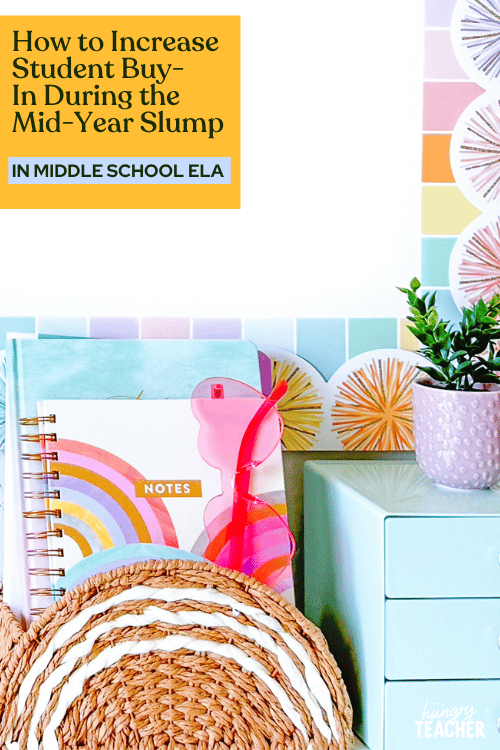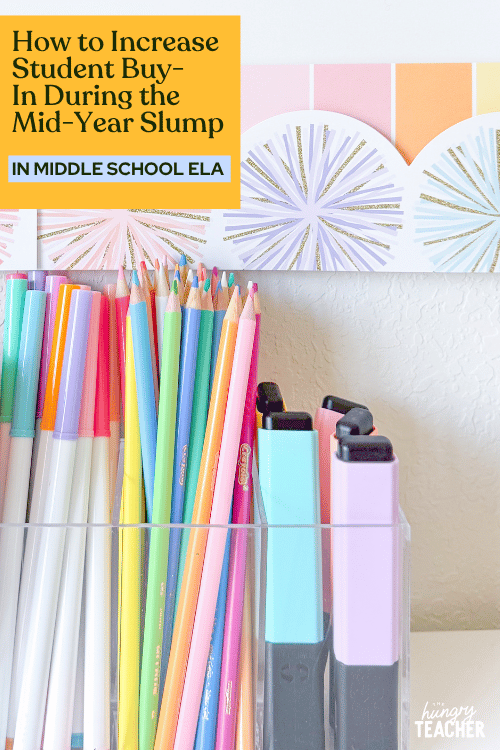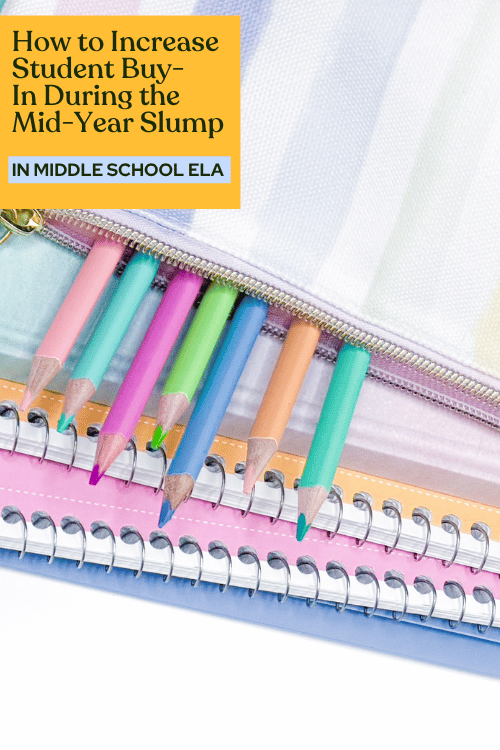hey friend!
I'm Martina.
I provide practical, time-saving strategies that actually work—so you can engage your students, teach effectively, and reclaim your time from the exhausting planning-grading cycle.
Browse Our ELA Resources
How to Increase Student Buy-In During the Mid-Year Slump
If you’ve been teaching for a while, you know the energy and momentum in a classroom ebbs and flows throughout the year. Some seasons, everything clicks—students are engaged, and your lessons unfold just the way you envisioned. But during other times of the year, it feels like you can’t catch a break. You’re begging for attention during each lesson, and students are checking out (or even head down on their desks). When you hit that mid-year slump, it’s tempting to ride it out and hope that things will get better after a weekend or holiday. Or you can try a few strategies to increase student buy-in and get your classroom back on track.

What is a Mid-Year Slump?
While your classroom can lose momentum at any time in the year, it’s a pretty common complaint around the middle of the school year. Have you heard of the October Slump or October Blues? Yep, there’s a reason it has a name. As the holidays pile up and routines settle in, student engagement often dips.
But like I said, this slump can happen anytime in the year. Sometimes it has to do with outside factors, like a busy sports season that’s draining student energy. Or things going on inside the classroom, like content or activities that are not holding students’ attention.
The good news is that you can beat the mid-year slump. It doesn’t have to be an inevitable part of your year. It just takes a bit of creativity and a willingness to try new things.
How to Increase Student Buy-In (and Beat the Mid-Year Slump)
No one wants to spend weeks (or months) fighting classroom slog. You want to get students back on track, so they’re engaging with your lessons and learning those skills. If you start to feel the mid-year slump, there are plenty of ways to re-energize your classroom and spark student engagement again.
#1 Student Choice
Of course it’s on the list: the age-old strategy of student choice. There’s a reason student choice is so effective, and it’s because when you give students the chance to choose, they already have more buy-in and engagement. They get to choose what sounds most interesting or fits their skill set the best.
There are a lot of different ways for students to make choices. The most classic example is offering a choice in an assignment, like through a choice board. But you can also offer student choice with the book they read, the essay prompt they write about, or the book report project they complete.
#2 Book Clubs
Technically, this ties back to student choice, but it deserves its own category. Book clubs are one of my favorite ways to increase student buy-in. Instead of forcing the whole class to read the same book or reading the book together as a class, you turn that power over to students.
There are lots of different ways to set up book clubs, but typically, students get to choose the book that they read, and then they will be grouped with students who are reading the same book. You’ll see a big boost in engagement with this strategy because students aren’t trudging through a novel that doesn’t interest them, and they get to talk about books with people in the class (which, no offense, is more fun than discussing with the teacher).

#3 Reading Community
One reason you might not be seeing student buy-in is that you haven’t set up a solid reading community. When you build a reading community, you set the expectation that everyone reads, and reading is something that we celebrate. It might sound like a lofty goal, but it’s possible.
If you notice in your mid-year slump that students are completely checked out during book clubs or when you read as a class, focus on building your reading community. Get to know students as readers. Host a book tasting to get a feel for what students are interested in. Build reading stamina slowly, day by day.
#4 Socratic Seminars
Maybe you’ve noticed a theme here, but a big part of waving goodbye to the mid-year slump is taking you, the teacher, out of the driver’s seat. You don’t need to lead every book discussion or make every choice for your students. Instead, you need to hand the power to them.
That’s what Socratic Seminar does. You’re handing over the reins of classroom discussion and allowing students to step up (and buy in). During a Socratic Seminar, students will lead the discussion around a novel. You’ll get them started with a guiding question, but from there, you sit back and let them take the lead. It’s okay if they disagree (actually, it’s more fun that way), as long as they can present their perspective in a respectful way.
#5 Creative Projects
Sometimes you just need to think outside the box. It’s easy to fall back on old activities and projects because it’s what you’ve always done. But it might not be what you need to exit the mid-year slump. Maybe instead of that old book report project, you let students create a digital poster or commercial for the book they read. You don’t have to reinvent the wheel or go overboard, but it doesn’t hurt to try new things – or at least give students the choice.

If you find yourself in a mid-year slump, join me inside The Hungry Teacher’s Hub! Think of this membership as your toolbox full of lessons, activities, and units that support student engagement. Whether you’re looking to mix things up, try new strategies, or just want some tried-and-tested lessons to pull from, The Hungry Teacher’s Hub has it all.
Leave a Reply Cancel reply
Want a sneak peek at teaching The Hungry Teacher way—with support, structure, and strategy?
When you join the waitlist for The Hungry Teacher’s Hub membership, you get three free classroom-ready resources: a theme unit, an expository writing unit, and a grammar unit introducing mentor sentences. Plus, you’ll get immediate access to a selection of exclusives from the Hub, including editable sub plans, pacing guides, and more.
No strings attached. Just resources you can use right now—and a heads-up when the Hub opens.
3 Free Middle School ELA Units—yours to keep!
JOIN THE WAITLIST + A FREE GIFT
Where to next, line leader?
Welcome to The Hungry Teacher! We create resources that are easy to use, practical, and get results. Teach with confidence—and make it home before dinner.
xo, the hungry teacher